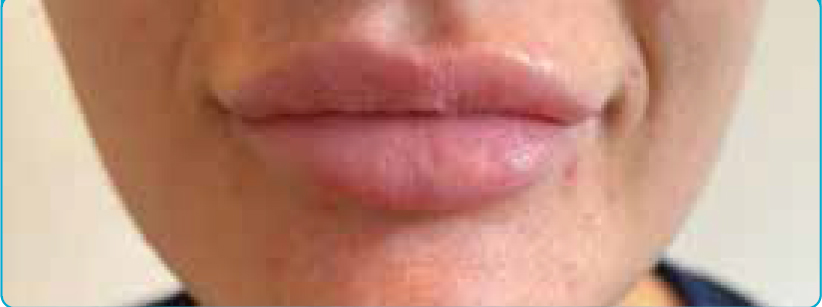

Introduction
A27 year old female attended a consultation with me to discuss treating her overfilled lips. After assessment of the lips it was clear that the filler had migrated above the vermillion border and into the wrong place, resulting in the undesireable ‘filler moustache’. After a thorough consultation and explanation of the natural anatomy of the lips, the patient agreed on the clinical plan to dissolve the lips and return 2 weeks later for a further assessment to decide if refilling was appropriate.
Emotions and strategies when dealing with the case
I always let my patients lead the consultation by listening to their areas of concern before offering any potential solutions and/or treatment options. Education is key in aesthetics and although the patient believed that adding more filler could rectify the problem, after time and education on the natural anatomy of the lips, she was then better placed to make an informed decision regarding the best treatment plan. I explained the reasons why adding more filler could make the lips look more unnatural and potentially lead to further migration.
Telling patients that their lips look overfilled can feel uncomfortable, but as long as you have the tools to explain the anatomy and physiology of the aging face, the patient should respect your expertise in the field. It is important to remember that we are the experts in aesthetics. As some patients will not want to be dissolved, it is still important to have a process in place to explain to the patient why you would not reommend adding more filler, and then suggest they find an alternative practitioner. It takes experience to tactfully explain you are not the right clinician for them.
» Telling patients that they look overfilled can feel uncomfortable, but as long as you have the tools to explain, the patient should respect your expertise «


The procedure
After the consultation, my patient was happy to proceed with treatment. After a medical history ascertaining she was a suitable candidate for dissolving, we booked in a date for her to return. I then saw the patient 2 weeks later to assess whether or not she required further dissolving. When the patient returned, she was very happy with her natural look and had forgotten that her natural lips were already a nice shape.
Advice for practitioners when handling a complicated case
The dissolving of unnatural fillers has emerged as a solution for those seeking to revert to a more natural and subtle look. Injectable hyaluronidase, an enzyme that breaks down hyaluronic acid, a common ingredient in many fillers, has become a key tool in this process. This procedure allows individuals to undo the effects of previous injections and restore a more authentic appearance. The patient can then be retreated in a more holistic way without being overfilled.
Benefits of dissolving unnatural fillers
Restoration of facial harmony:
Dissolving unnatural fillers helps restore facial harmony by softening exaggerated features and allowing natural contours to shine through.
Enhanced facial expressions:
Natural-looking results allow for improved facial expressions, avoiding the frozen or immobile appearance associated with excessive filler use.
Personalised beauty:
Embracing natural aesthetics enables patients to appreciate and highlight their distinctive features, fostering a sense of individualised beauty.


Reduced stigma:
As the natural aesthetic movement gains momentum, there is a reduced stigma associated with visible signs of aging, contributing to a more inclusive and diverse definition of beauty.
Conclusion
The rise in people dissolving unnatural-looking fillers in medical aesthetics signals a significant cultural shift towards embracing authenticity and natural beauty. The dissolving process allows individuals to reclaim their unique features, promoting a more inclusive and diverse standard of attractiveness. As the natural aesthetic movement continues to evolve, the beauty industry is challenged to adapt, emphasising enhancement over transformation and celebrating the beauty found in the individuality of every face.




